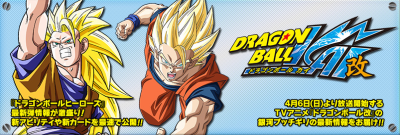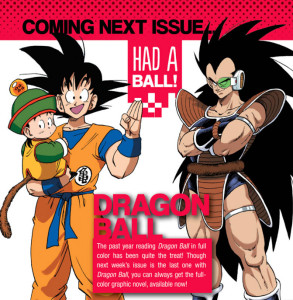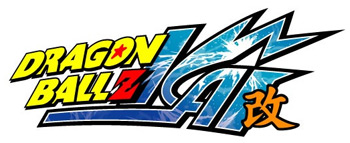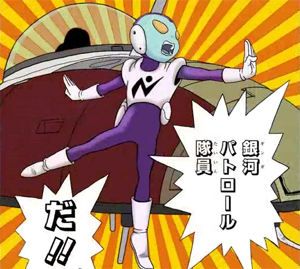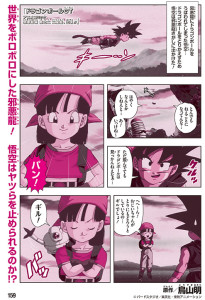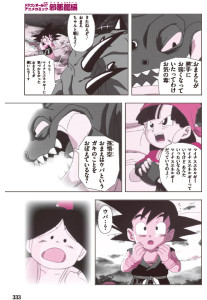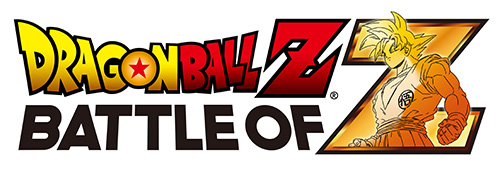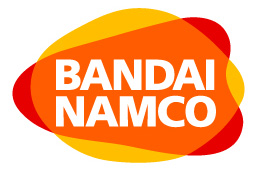With the official worldwide release of the new fighting game Dragon Ball Z: Battle of Z on game consoles, many more fans are becoming familiar with the God of Destruction from Dragon Ball Z: Battle of Gods. It seems that Bandai Namco’s decision to go with a localization of “Beerus” for his name has confused more than a few fans out there. What exactly is the name of the God of Destruction…?
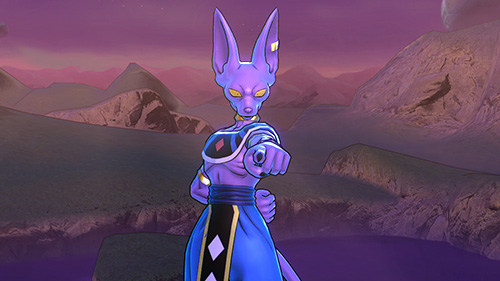
A basic understanding of how words (and in this case names) are written in Japanese is the first step to understanding. There are three types of “alphabets”, so to speak, in Japanese: katakana (very basic phonetic symbols used to represent sounds, and typically also used to represent sounds in foreign words), hiragana (slightly more complex phonetic symbols also used to represent sounds, usually ones native to Japanese), and kanji (more elaborate characters used to represent things or ideas, but also having one or more corresponding pronunciations).
Very few Dragon Ball character names are written with kanji. The small selection includes Son Goku (孫悟空) and his children Son Gohan (孫悟飯) and Son Goten (孫悟天). A few others include Tenshinhan (天津飯), Chiaotzu (餃子), and others with titles rather than names, such as Kaiōshin (界王神) and Kame-Sen’nin (亀仙人).
Most Dragon Ball character names, however, are written in katakana. With so many names being puns rather than the exact words themselves, it makes sense to represent them phonetically this way. Even when the names literally are the exact words, they may be exact words from other languages, and so katakana still makes the most sense (things like “Trunks” as トランクス and “Cell” as セル).
That is one of the most important first points: virtually every given character name in the franchise is a pun on something, rather than an actual “name” (things like “Mike” or “Akira”).
A somewhat soft policy we have adopted here at Kanzenshuu is that, until we know the source of the pun for a new character’s name, we will typically write it out as an exact romanization of the original kana (and perhaps even further write that out in quotes). As such, for quite some time, we wrote out ビルス as “Birusu” (ビ = bi, ル = ru, ス = su).
And this is where the investigation begins!
With ウイス (uisu) so closely looking as if it came from “whiskey” (ウイスキー or uisukī), we asked Battle of Gods scriptwriter Yūsuke Watanabe if both names may actually be a play on alcoholic beverages, and furthermore, if ビルス may actually be a play on “pilsner”. Watanabe responded that this was in fact not the source of the name puns, so it was back to square one for us!
It turned out there was more to this story, however. We have since learned (via an interview with Watanabe in DVD & Blu-ray Magazine) that in the original drafts for the film, Watanabe had written a scenario in which the God of Destruction was actually the one responsible for originally infecting the Saiyans with evil. This was the pun source Watanabe had intended (as explicitly stated in an interview with GetNavi): that “Birusu” was in fact a sort of “virus”.
This is where things start getting complicated… at least for a little bit.
Initially in Japan, the word “virus” was taken directly from Chinese, written as 病毒 (byōdoku), but this has since been phased out of use. In 1953, the “Japanese Society for Virology” established an alternative Japanese approximation of the word based on the original Latin pronunciation, which is written in katakana as ウイルス (uirusu). However there was much confusion, as the “Japanese Association of Medical Sciences” had begun using a different approximation based on the German pronunciation of the word, which is also written in katakana as ビールス (bīrusu). In general, the former katakana approximation (ウイルス) is the more common of the two these days. The latter of the two approximations is still used, although chiefly within the medical field. In addition, the horticultural field uses yet another approximation, バイラス (bairasu), which is (rather obviously) derived from the English pronunciation of the word.
When original manga author Akira Toriyama came on board and switched up a great deal of the film’s back-history, however, he — admittedly, in an interview with the Asahi Shimbun — mistook the pun source for “Birusu”, thinking it came from “beer”, and then followed suit naming Whis (ウイス or uisu) after “whiskey”, another alcoholic beverage.
With all that in mind, it is absolutely clear to see how the character’s name of ビルス was shortened from the Japanese-via-German ビールス. Shortening or elongating a sound is a common tactic for name puns in the series. The character we write as “Appule” is written in Japanese as アプール (apūru), whereas the English word for “apple” would be written as アップル (appuru). Another name pun tactic is to swap around the placement of syllables. The character we write as “Tullece” is written in Japanese as ターレス (tāresu) whereas “lettuce” would be レタス (retasu).
Tullece is a perfect example in comparison to “Birusu”. Such a spelling adapts it into our alphabet, preserves the pronunciation of the character’s name in Japanese, and preserves the name pun source. For the longest time, however, fansubbers had no clue what to call the character in their subtitle scripts. Many groups, particularly ones with multiple projects and a lack of deeper familiarity with a particular franchise, would simply make something up to suffice for getting the product out the door. For many years, fans referred to the character as “Taurus” based on these poorly-researched fansubs:
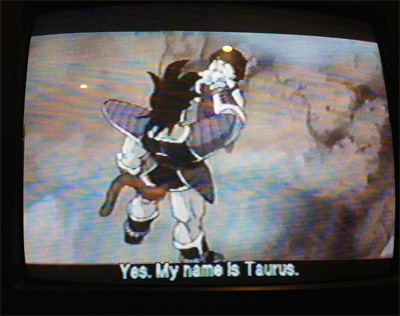
Simply being used in a fansub does not validate a spelling, however. In this case, a “Taurus” transliteration neither preserves the pronunciation nor preserves the pun.
With no “official” English adaptation of Battle of Gods available for quite some time (coming via theatrical screening subtitle tracks many months after its Japanese debut, itself many months after character name reveals), fans were left to their own devices to come up with a spelling for ビルス. Many fans, in an attempt to “Americanize” a spelling as much as possible, went with “Bills” rather than a straight-up romanization of “Birusu”. This somewhat preserves the pronunciation, but does little more. In fact, writing the name as “Bills” would be pretty equivalent to adapting トランクス as “Tolanks” instead of “Trunks”; sure, it is a legitimate transliteration of the spelling, but what does it accomplish? “Bills” was a guess, and a very poor one at that.
Knowing that ビルス came with an original pun source of “virus” and a supplementary pun source of “beers”, as a bit of inside-baseball, we at Kanzenshuu decided upon a spelling of “Beerus” which, again, preserved both the pronunciation and the name pun(s).
Meanwhile, there was one bit of Japanese merchandise that went with a spelling of “Bills”: a third-party DSi LL (XL) external case, which can pretty much be disregarded entirely.
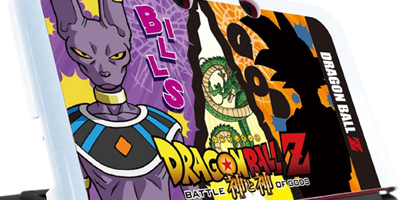
Along with the movie’s theatrical debut in Japan came a program guide book. Inside, the character’s name was adapted into our alphabet — “more-officially”, so to speak, from the actual company that produced the film — as “Beers“:
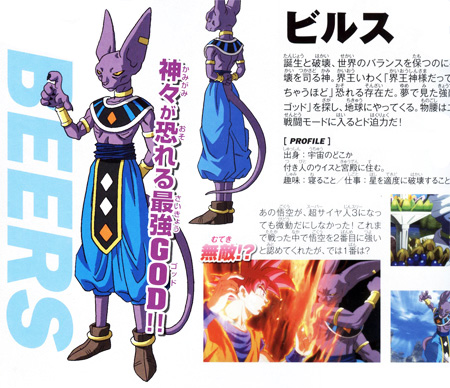
Sadly, many international screenings of Battle of Gods are being sent around with a spelling of “Bills” in the subtitle track, despite this “official” spelling of “Beers” from Toei.
For the time being, we plan on continuing with our “Beerus” spelling, and it seems as if Bandai Namco (and, in turn, likely FUNimation) will follow suit. In fact, FUNimation voice actor / director / franchise-evangelist Chris Sabat personally fought for the “Beerus” name spelling to both preserve the intentions of the original Japanese staff as well as to provide a far more easily marketable/searchable/monetizable spelling.
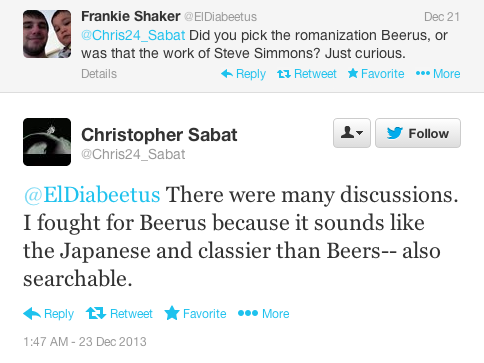
So in a nutshell?
The original intent of pun source was “virus”, the pun source was changed to “beer”, bad fansubs exist, and the official “English language” adaptation/transliteration is either “Beers” or “Beerus”.
This was an awful lot to say that, more than anything else, we simply hope fans will drop the “Bills” spelling. Like “Taurus”, it never made any sense to use, and will likely be looked back upon in several years’ time with the same amount of amused-scorn, if not forgotten entirely.
